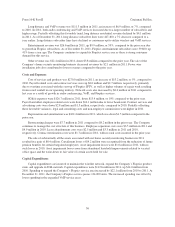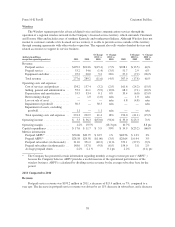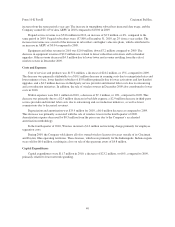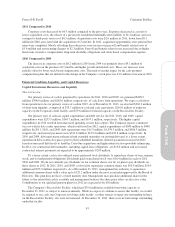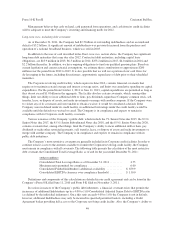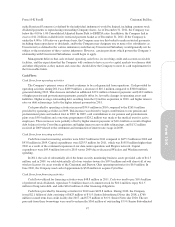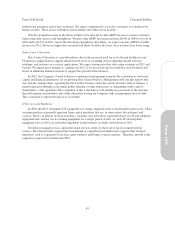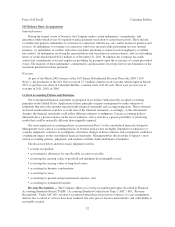Cincinnati Bell 2011 Annual Report Download - page 164
Download and view the complete annual report
Please find page 164 of the 2011 Cincinnati Bell annual report below. You can navigate through the pages in the report by either clicking on the pages listed below, or by using the keyword search tool below to find specific information within the annual report.
Management believes that cash on hand, cash generated from operations, and cash from its credit facilities
will be adequate to meet the Company’s investing and financing needs for 2012.
Long-term view, including debt covenants
As of December 31, 2011, the Company had $2.5 billion of outstanding indebtedness and an accumulated
deficit of $3.2 billion. A significant amount of indebtedness was previously incurred from the purchase and
operation of a national broadband business, which was sold in 2003.
In addition to the uses of cash described in the Short-term view section above, the Company has significant
long-term debt maturities that come due after 2012. Contractual debt maturities, including capital lease
obligations, are $18.9 million in 2013, $6.3 million in 2014, $253.2 million in 2015, $6.0 million in 2016 and
$2.2 billion thereafter. In addition, we have ongoing obligations to fund our qualified pension plans. Based on
current legislation and current actuarial assumptions, we estimate these contributions to approximate $200
million over the period from 2012 to 2019. It is also possible that we will use a portion of our cash flows for
de-leveraging in the future, including discretionary, opportunistic repurchases of debt prior to their scheduled
maturities.
The Corporate revolving credit facility, which expires in June 2014, contains financial covenants that
require us to maintain certain leverage and interest coverage ratios, and limits our cumulative spending on capital
expenditures. For the period from October 1, 2011 to June 11, 2013, capital expenditures are permitted as long as
they do not exceed $1.0 billion in the aggregate. The facility also has certain covenants, which, among other
things, limit our ability to incur additional debt or liens, pay dividends, repurchase Company common stock, sell,
transfer, lease, or dispose of assets, and make investments or merge with another company. If the Company were
to violate any of its covenants and were unable to obtain a waiver, it would be considered a default. If the
Company were in default under its credit facility, no additional borrowings under the credit facility would be
available until the default was waived or cured. The Company is in compliance and expects to remain in
compliance with its Corporate credit facility covenants.
Various issuances of the Company’s public debt, which include the 7% Senior Notes due 2015, the 8
1
⁄
4
%
Senior Notes due 2017, the 8
3
⁄
4
% Senior Subordinated Notes due 2018, and the 8
3
⁄
4
% Senior Notes due 2020,
contain covenants that, among other things, limit the Company’s ability to incur additional debt or liens, pay
dividends or make other restricted payments, sell, transfer, lease, or dispose of assets and make investments or
merge with another company. The Company is in compliance and expects to remain in compliance with its
public debt indentures.
The Company’s most restrictive covenants are generally included in its Corporate credit facilities. In order to
continue to have access to the amounts available to it under the Corporate revolving credit facility, the Company
must remain in compliance with all covenants. The following table presents the calculation of the most restrictive
debt covenant, the Consolidated Total Leverage Ratio, as of and for the year ended December 31, 2011:
(dollars in millions)
Consolidated Total Leverage Ratio as of December 31, 2011 ......... 4.75
Maximum ratio permitted for compliance ........................ 6.00
Consolidated Funded Indebtedness additional availability ........... $ 659.9
Consolidated EBITDA clearance over compliance threshold ......... $ 110.0
Definitions and components of this calculation are detailed in our credit agreement and can be found in the
Company’s Form 8-K filed June 11, 2010 and Form 8-K filed on November 3, 2011.
In various issuances of the Company’s public debt indentures, a financial covenant exists that permits the
incurrence of additional Indebtedness up to a 4:00 to 1:00 Consolidated Adjusted Senior Debt to EBITDA ratio
(as defined by the individual indentures). Once this ratio exceeds 4:00 to 1:00, the Company is not in default;
however, additional Indebtedness may only be incurred in specified permitted baskets, including a Credit
Agreement basket providing full access to the Corporate revolving credit facility. Also, the Company’s ability to
46
Form 10-K Part II Cincinnati Bell Inc.


